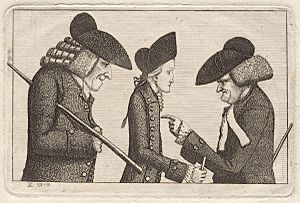Hugo Arnot facts for kids
Hugo Arnot of Balcormo (born December 8, 1749 – died November 20, 1786) was a Scottish advocate (a type of lawyer), writer, and a person who campaigned for what he believed in.
People described him as very tall but also very thin. He was quite a unique person!
Contents
Life of Hugo Arnot
Hugo Arnot was born as Hugo Pollock on December 8, 1749. His birthplace was Leith, a port town in Scotland. His father was a merchant and owned ships.
Hugo later changed his last name to Arnot. He did this after he inherited property from his mother in a place called Balcormo in Fife. He studied law and became a member of the Faculty of Advocates in 1772. This meant he could work as a lawyer. From 1773 until he died, he lived on Princes Street in Edinburgh. He was one of the first people to live there.
Hugo Arnot's Writings
In 1779, Hugo Arnot published his famous book, History of Edinburgh. Later that year, a version with more pictures came out. New editions of the book were printed in 1788 and 1816. For his book, Arnot used old handwritten documents. He looked at records from the Edinburgh City Archives and the National Records of Scotland.
In 1785, he published another important book. It was called Collection of Celebrated Criminal Trials in Scotland. Both of his books were copied and sold illegally in Ireland.
Challenges and Campaigns
Hugo Arnot became old before his time because he had asthma. He was also known for being a bit grumpy and using sharp words. He only liked to take cases where he truly believed his client was right. These things sometimes made it hard for him to get many clients as a lawyer.
Many funny stories are told about his unusual personality. He wrote many papers about local politics. He spoke out against local taxes and road tolls. He felt these taxes were unfair, especially to poorer people. He even managed to delay the building of the city's South Bridge for ten years!
Family and Legacy
Hugo Arnot passed away on November 20, 1786. He left behind eight children. He is buried in the South Leith Parish Churchyard. He had a special enclosure built there for himself just before he died.
His daughter, Christian Arnot, married Dr Peter Reid. Their son was David Boswell Reid.
Hugo Arnot's Views
In his writings, Hugo Arnot was very direct and spoke his mind. People had mixed feelings about his strong opinions. In his book about criminal trials, he clearly wrote about decisions he thought were unfair. He even used strong words like despotism (meaning cruel and unfair rule).
He believed that as a country became more advanced, its ideas about justice should also improve. He thought that old laws were often harsh because they were made when societies were less developed. He felt that even if laws hadn't changed much, people working in the legal system were becoming kinder.
In 1777, Arnot published a playful essay called 'Essay on Nothing'. He first read this essay at a debating club called the Speculative Society. Some people didn't like his sarcastic jokes in the essay. However, he later became very involved in church activities. The leaders of Edinburgh recognized his contributions to society. They even gave him the freedom of the city, which is a special honor.
Hugo Arnot was a favorite subject for John Kay. Kay was a famous artist in Edinburgh who drew funny pictures of people. He loved to draw Arnot because he was so extremely thin!


